Author: Biteye core contributor Crush
Editor: Biteye core contributor Crush
Community: @BiteyeCN
In the current ecosystem with such a rich on-chain ecology, cross-chain bridges have become an indispensable part of the entire ecosystem. Despite the frequent occurrence of news about cross-chain bridges being hacked, they still provide convenience for users to transfer assets.
- Report: Modular L2 Public Chain Eclipse is a Promising Newcomer to Watch
- With the launch of Memeland and $MEME token during the Age of Great Navigation, can we find our own ONE PIECE?
- Binance’s new IEO project Arkham: On-chain information sharing platform or accomplice to betrayal?
With the development of Ethereum layer 2 networks such as Arbitrum and Optimism, some cross-chain bridges focusing on asset transfer between L2s have gradually emerged. In this article, we will introduce two very useful cross-chain bridges: Orbiter and Layerswap.
By introducing the principles, operations, and some details of these two cross-chain bridges, we can understand the current situation of L2 cross-chain bridges and make the best choice when crossing chains.
01. Why choose Layerswap and Orbiter
Some readers may wonder, with so many cross-chain bridges on the market, why choose to introduce only these two? There is another reason for this, let me explain.
Official endorsement
First of all, what is the most important thing for cross-chain bridges? I say it’s security, and I don’t think anyone would disagree! As a tool for asset transfer, just like the escorts who transported goods in ancient times, security is naturally the top priority. In addition, as I mentioned at the beginning, cross-chain bridges are frequently hacked. Even if they offer negative transaction fees, an unsafe cross-chain bridge will definitely not be used by users.
By visiting the official websites of zkSync and Starknet, you can clearly see that these two cross-chain bridges are recommended by them in the top positions. With the official endorsement, their credibility naturally goes up.
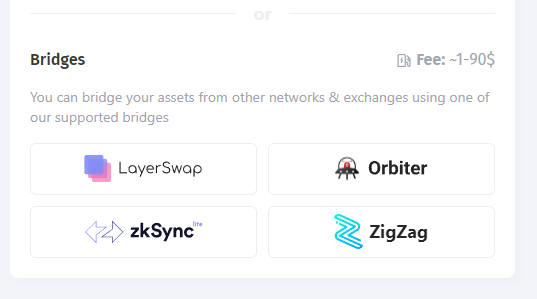
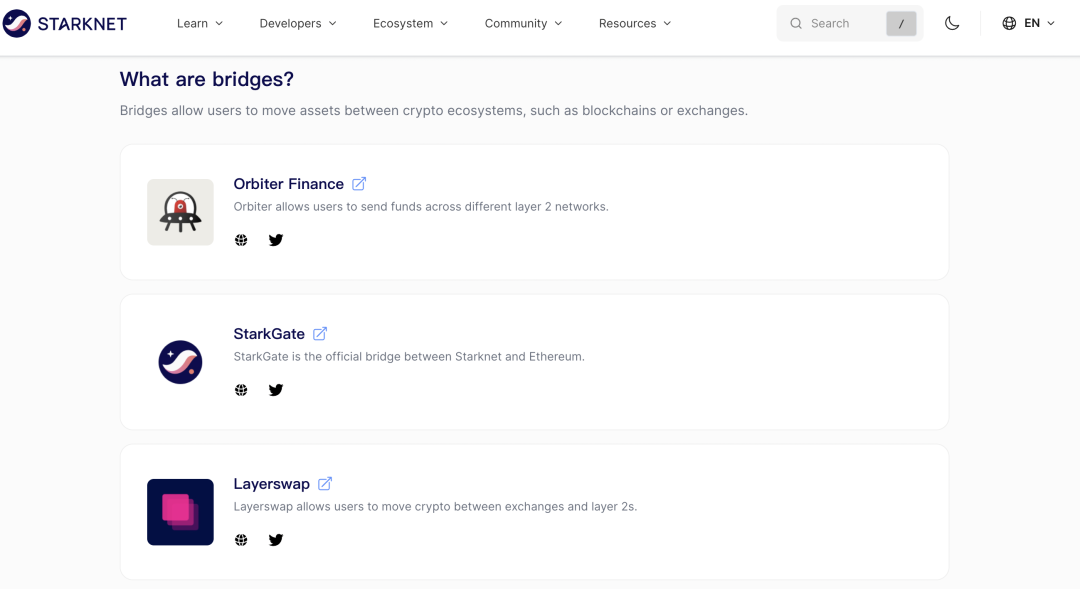
Airdrop expectations
As a Web3 user, airdrops are the rewards that cannot be missed. Among all airdrops, public chain airdrops are usually the most generous and have the widest coverage. Currently, the two most anticipated public chain airdrops should be zkSync and Starknet.
2. Layerswap
Layerswap did not disclose too much about the technical aspects in its own user manual, but from its early cross-chain style, Layerswap is different from Orbiter above.
When Layerswap was born, the Layer 2 network was not yet mature, and many users who wanted to experience Layer 2 such as Arbitrum and Optimism could only withdraw funds from the exchange to the ETH mainnet first, and then use the official cross-chain bridge of the mainnet to cross-chain assets to Layer 2.
At that time, Layerswap launched a tool called Bransfer and registered its own account on major exchanges. If users need to cross-chain ETH to the Layer 2 network, they only need to transfer their assets to Layerswap’s exchange account. Then, they will send a fund to your target address on the Layer 2 network.
Since internal transfer within the exchange is free of charge, you only need to pay almost only the Layer 2 transfer fee, plus some fees charged by Layerswap, which can be said to be very cheap.
How to confirm the internal transfer? Here, Bransfer is used. Users need to apply for a read-only API on the exchange, and Layerswap can read your transfer data if they get your API.
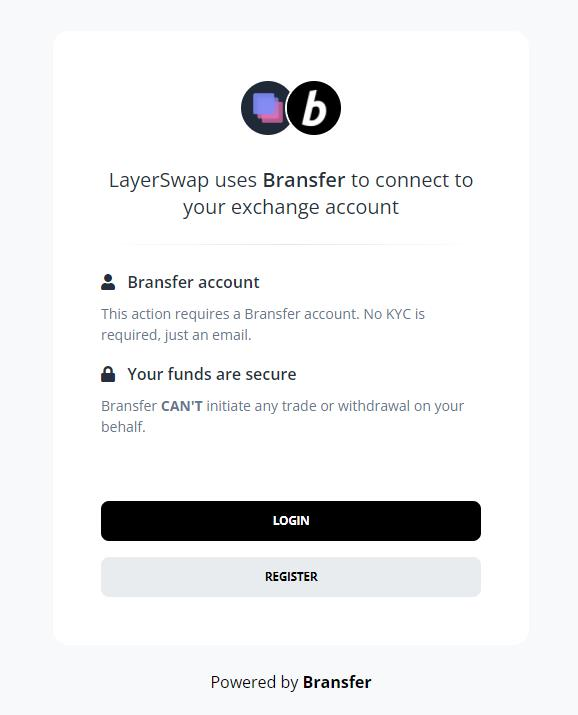
With the development of Layer 2, most exchanges have supported the deposit and withdrawal of Arbitrum and Optimism, and even zkSync and Starknet, which have not yet been launched, have been successively supported.
Once the exchanges support these Layer 2s, Layerswap seems to have lost its advantage. Therefore, in the latest version v2, Layerswap migrated Bransfer to become a built-in function, and users no longer need to register Bransfer.
In addition, due to the merger of the two, their transaction history has also been unified, and users can directly view it on Layerswap.
From the history of Layerswap’s development and the current constraints on cross-chain funds, we can guess that it is probably still using its own funds to help users cross-chain and earn handling fees.
Actual operation
1. Orbiter
https://orbiter.finance
Here, I will demonstrate the cross-chain from Arbitrum to zkSync Era. First, we open the Orbiter website, and we use the V2 version directly, which can support more cross-chain tokens.
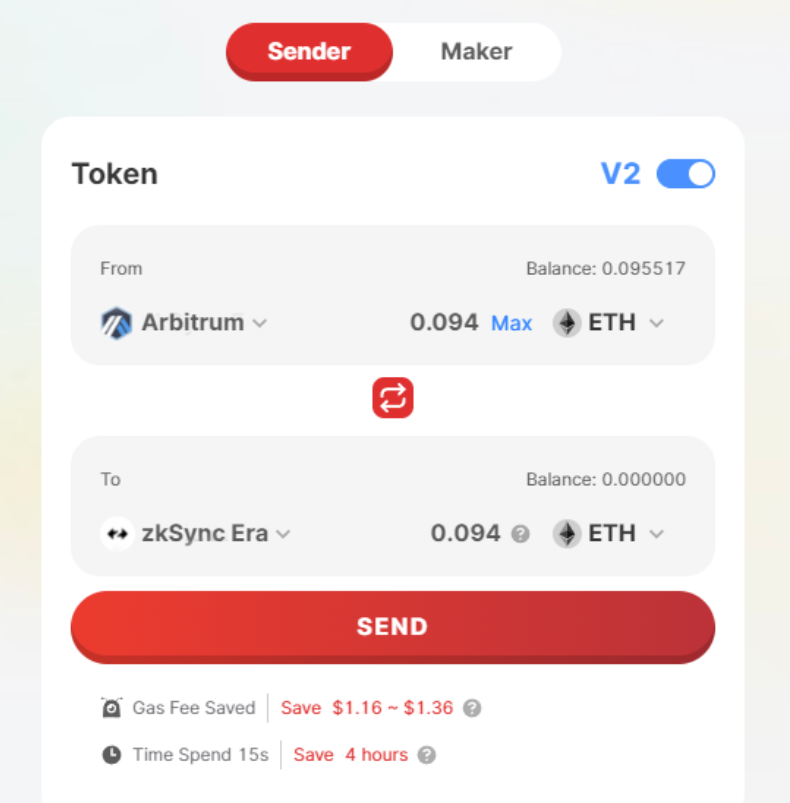
As shown in the figure below, the interface is very simple. Just select the corresponding chain and token, and enter the amount. The bottom will display how much GAS fee and time you have saved for you. If you want to see the actual cost, put the mouse pointer on the question mark to display the official cross-chain bridge fee and the cost of using Orbiter.
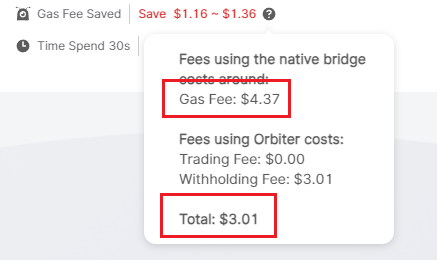
If you want to view your cross-chain history, you can check it in the History in the upper right corner. In addition to the cross-chain function, Orbiter has also launched an L2 data dashboard. Click L2 Data in the upper left corner to see the overall transaction data of the second layer and the data of each project separately.
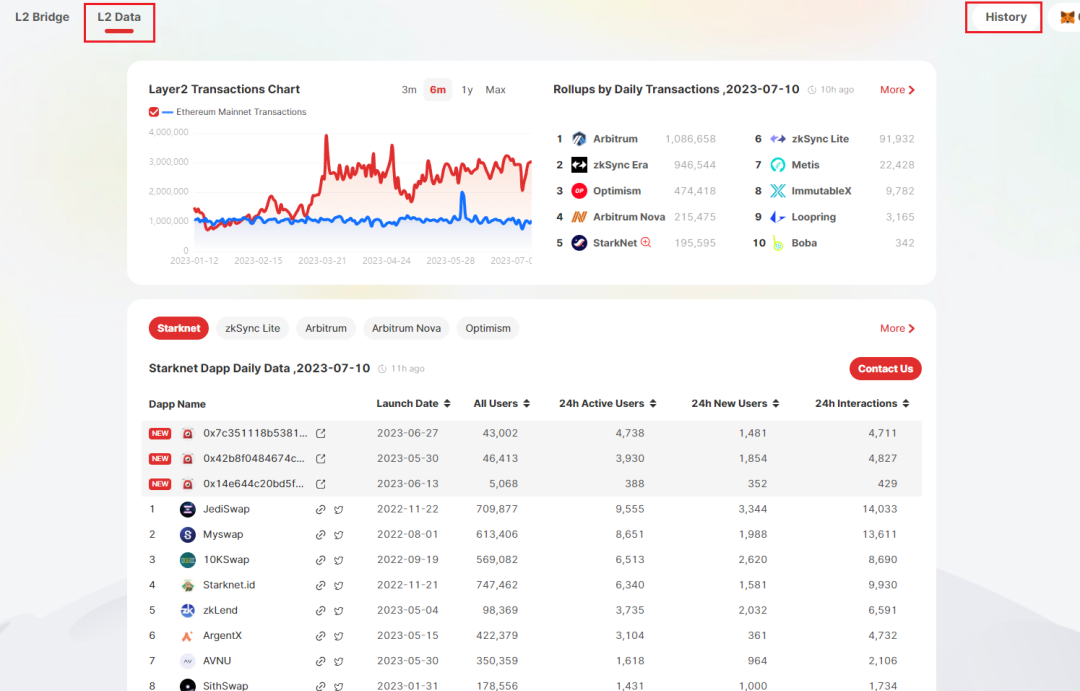
2. Layerswap
https://layerswap.io/app
Open Layerswap’s official website. Because it supports direct cross-chain transactions of exchanges, here we will try to cross-chain ETH from OKX to zkSync Era.

After selecting OKX and zkSync Era, enter the amount to be cross-chained. Here, the type of token cannot be changed, only ETH can be selected, and the maximum limit is 1 ETH.
There is a customer service button in the upper right corner. If there is any problem during the cross-chain process, you can contact them directly. You can also see the transaction history in the “Transfer” section.
The bottom will display the amount of tokens you will receive. Here, it shows that I will receive 0.99802 ETH, including 0.001198 ETH of Layerswap fee and 0.01 of exchange fee.
For the receiving address, you can either fill in the same address as the sending address, or customize another address, which is more convenient.
After clicking “Swap Now”, you will enter the transfer interface, and you need to withdraw 1 ETH in OKX and send it to the receiving address provided by Layerswap. The public chain sent here can be selected, and the default is Arbitrum to save transaction fees.
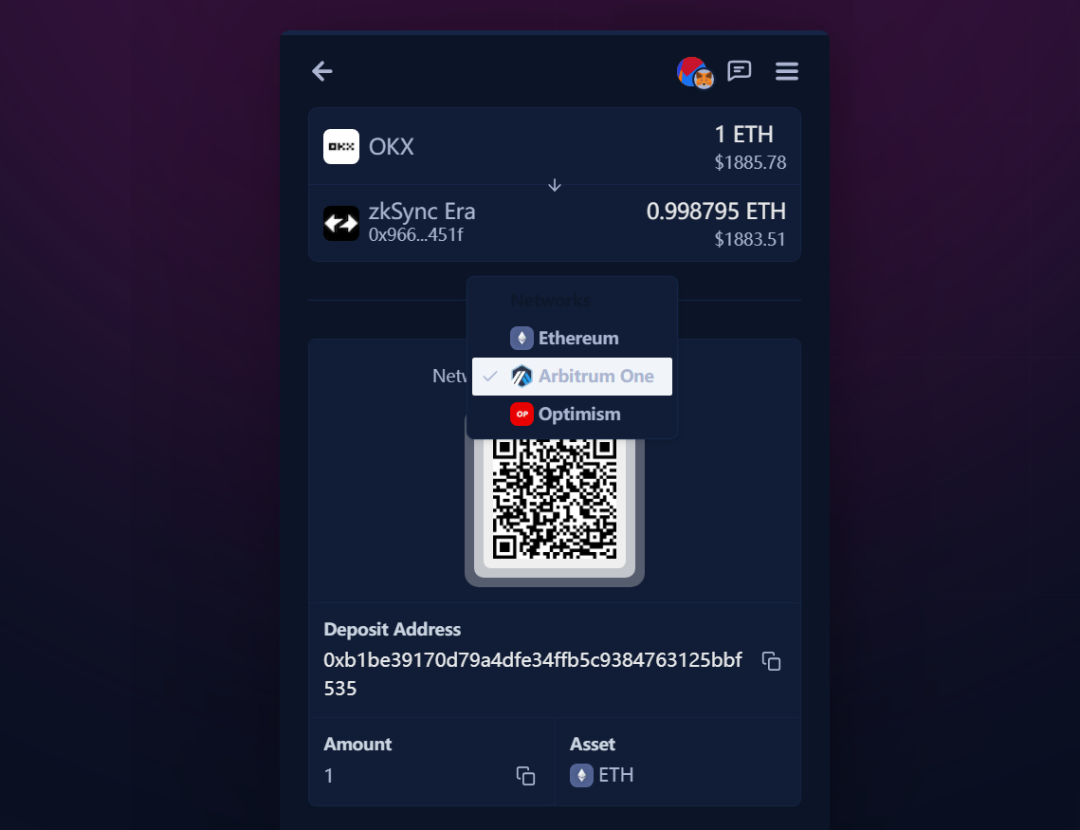
After you have completed the operation of withdrawing from the exchange to this address, this interface will automatically detect the arrival of funds, and then transfer this funds to your zkSync Era address.
03. Detail Comparison
Number of Supported Public Chains
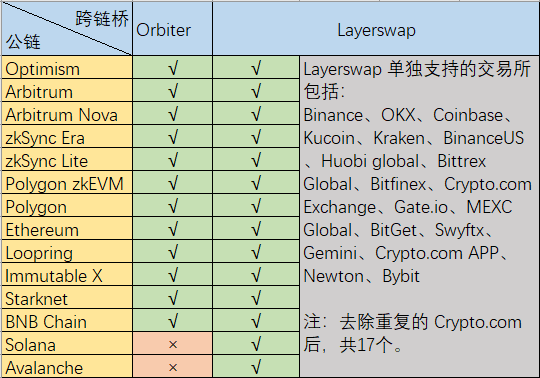
From the number of supported public chains, Layerswap has two more than Obiter, which are Solana and Avalanche, and support withdrawal cross-chain for exchanges.
However, having more quantity does not mean better quality. Solana has not been as active as before after the FTX crash. The Avalanche ecosystem does not seem to have any particularly outstanding projects, and the overall activity is also relatively average. Therefore, the lack of support for these two chains by Orbiter is not a big problem.
Cross-Chain Speed
In terms of cross-chain speed, we will cross from any chain to zkSync Era.
Orbiter’s time is basically around 30 seconds, with the mainnet speed slightly slower, which may take 45 seconds, and if the mainnet is too slow, it may take longer. The fastest is the BSC network, which only takes 15 seconds to cross to the zkSync Era.
Layerswap’s cross-chain speed is generally slower, basically around 2 minutes. Among them, the slowest speed for polygon to cross to zkSync Era, exceeding 1 hour.

Therefore, in terms of cross-chain speed, Orbiter still surpasses Layerswap.
Cross-Chain Fees
Most of the cross-chain fees between Orbiter’s secondary layers are between 2U~4U, usually fixed, and a few cross-chain fees increase with the increase of cross-chain amount, such as transferring ETH from zkSync Era to Arbitrum.
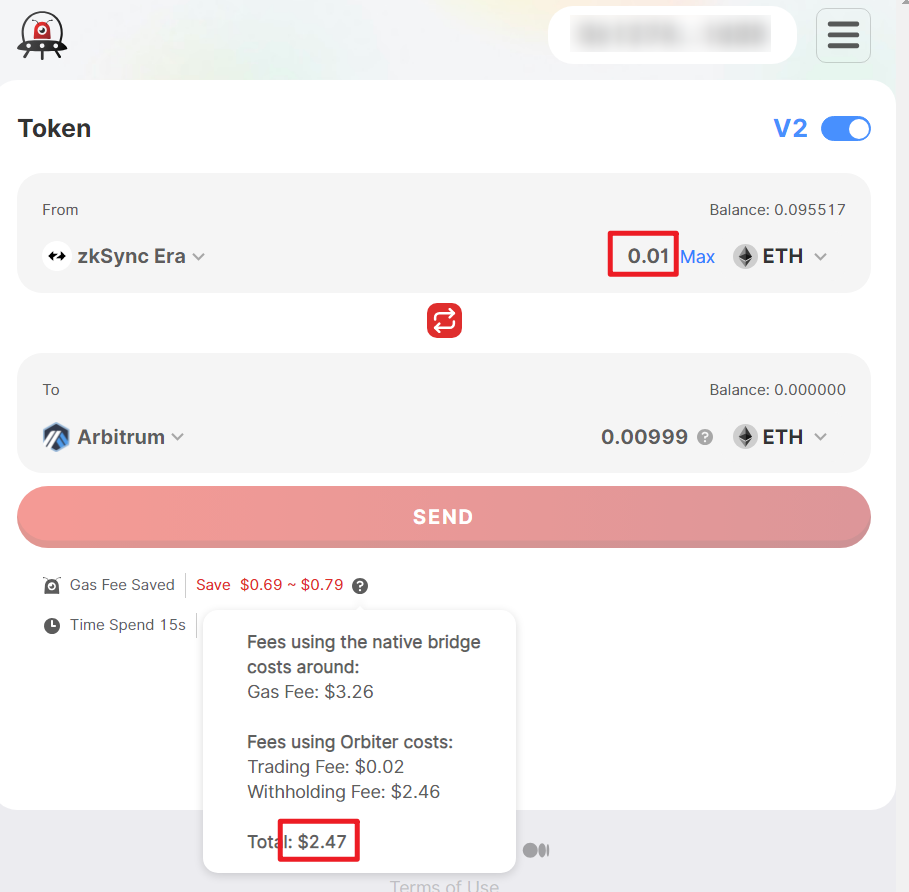
When the cross-chain amount is 0.01 ETH, the fee is 2.47 U.
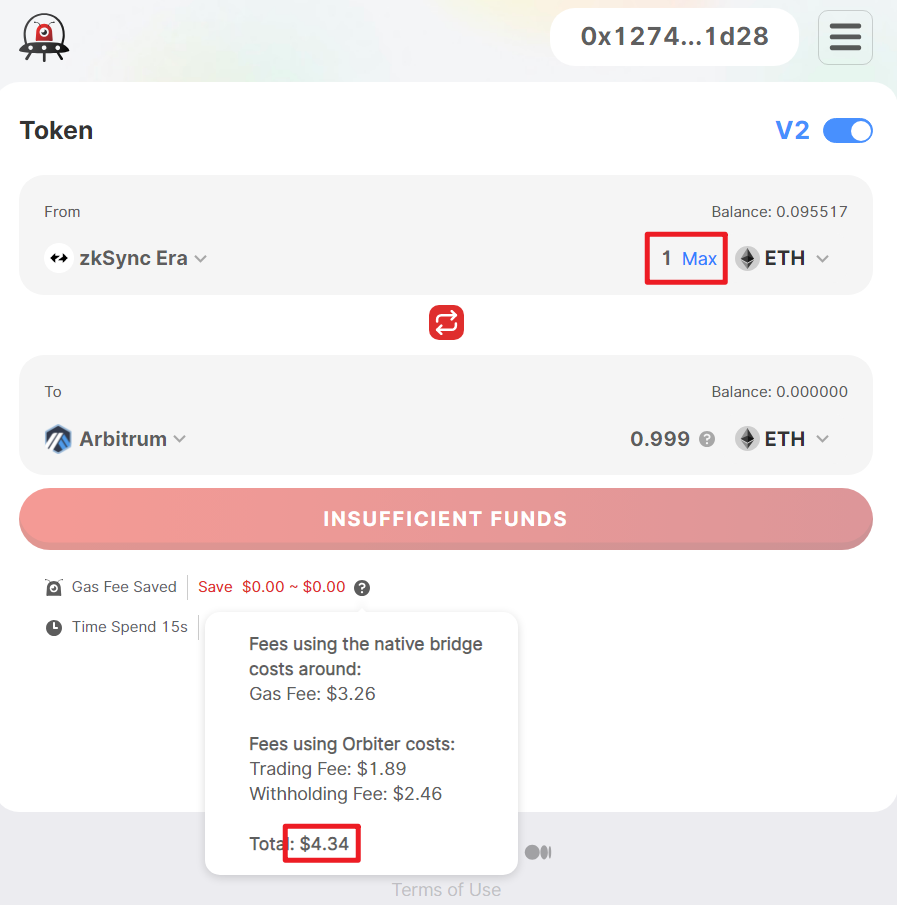
When we try to increase the cross-chain amount to 1 ETH, the cross-chain fee immediately rises to 4.43U.
The cost of cross-layer to mainnet is higher, starting at 14U handling fee, and the larger the cross-chain amount, the higher the handling fee, up to a maximum of 20U. Because Orbiter’s Maker has set restrictions on funds crossing to the mainnet, the maximum is only 10E.
The cost of cross-chain between the two layers of Layerswap is basically around 0.0016E, or 3U. Regardless of how cross-chain funds change, the handling fee is still relatively stable.
When we try to cross funds from the second layer to the Ethereum mainnet, the handling fee is actually cheaper than the transfer between the two layers. Overall, the cross-chain fee of Layerswap is still relatively stable, just like the withdrawal fee of the exchange.
Compared with each other, Layerswap seems to have a slight advantage in terms of cross-chain fees.
In addition to directly checking the cross-chain fees on the cross-chain bridge, you can also use Chaineye to query cross-chain fees.
https://chaineye.tools/bridge
After opening the tool, enter the relevant information of the cross-chain, and you can query the fees of each cross-chain bridge with one click.
(Sorted from fastest to slowest)
Security
From the principle mentioned above, Orbiter uses a whitelist mechanism to allow multiple liquidity providers with funds to provide cross-chain liquidity for users on various chains, while ensuring the safety of user funds by means of margin and arbitration mechanisms to avoid the risk of inaction by liquidity providers after receiving funds.
Compared with Layerswap, which provides liquidity through a single entity, the former seems to consider the safety of user funds more comprehensively.
04, Summary
Based on the above discussion, we can use the following strategies to complete daily cross-chain operations:
1. When the cross-chain funds are small, prioritize using Layerswap, which has lower fees but slightly slower speeds;
2. When the cross-chain funds are large, prioritize using Orbiter, whose liquidity is obviously more abundant, and can meet the cross-chain needs of larger funds, while Layerswap has a limit of 1ETH;
3. When it is necessary to cross from Layer 2 to the mainnet, prioritize using Layerswap, as the cost from Layer 2 to the mainnet is still the cheapest with Layerswap;
4. For users who have funds in exchanges and want to directly cross-chain to the target chain, prioritize choosing Layerswap, as it is the only one that supports exchanges;
5. For users who care more about time and security but do not care about fees, prioritize choosing Orbiter.
Like what you're reading? Subscribe to our top stories.
We will continue to update Gambling Chain; if you have any questions or suggestions, please contact us!